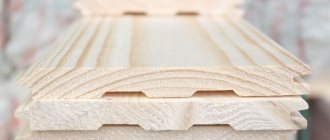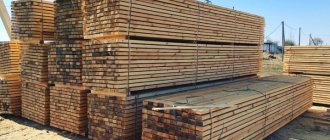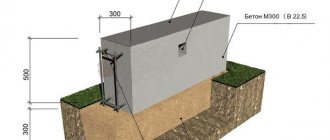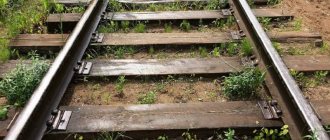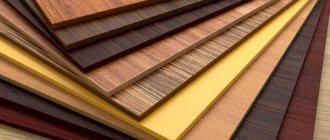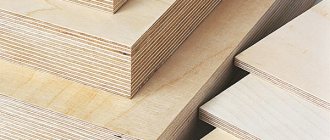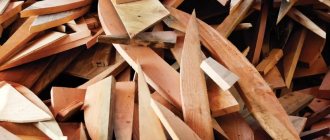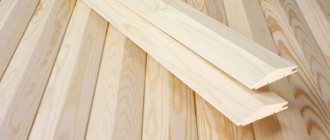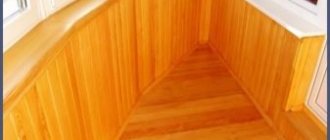At the beginning of the 20th century, no one even knew about lining. Although wood was actively used in construction and decoration. After the appearance of freight cars, which, in order to save money, were lined with wooden boards, the development of this type of wooden products began. Of course, they have been improved and improved fastening systems have been created. They also approved certain norms and standards that determine the dimensions of the lining.
To sheathe a house outside and inside, as well as to use it for finishing other buildings and structures, you need to decide on the appropriate type of material and select the right size.
Lining can be used for both interior decoration and exterior cladding. In this case, the size standard is relevant for both cases.
Don’t forget that there is a classic wooden lining, as well as analogues based on MDF and PVC. Here, too, there is a certain size, width, length and thickness.
But let's talk about everything in order. Let's start with wood, and then we'll touch on MDF and PVC lining, which also have their own standards and norms.
Main profile parameters according to GOST
The main parameters of the lining are regulated by GOST standards for profile parts made of wood for construction and for softwood lumber. As for the profile length, there are no strict regulations. As a rule, lining from 2 to 6 meters goes on sale. There are also no special requirements for the profile width; this parameter varies from 13 to 120 mm. Buyers, as a rule, prefer to purchase the type of profile that is convenient to transport.
The width and length of the profile are taken as a guide when it is necessary to determine the volume of products purchased. Regardless of the parameters of the lining, the installation principle of the product is identical, which is very convenient for the buyer. If repair or dismantling work is necessary, it will be very easy to find a similar profile of the required size.
On the product packaging, as a rule, the parameters are indicated in the following order: grade, thickness, width, length. The characteristics of the profile values largely depend on the type of wood from which it is made. It should also be taken into account that Russian standards do not correspond to European ones.
Calculation of required material
In order for us to correctly calculate the required quantity, we must know the dimensions of the panels. The size of the lining is not a mandatory standard, and this indicator has a wide range.
In accordance with GOST, the thickness of a standard board can vary from 1.2 to 2.5 cm, the average width is 15 cm, and the length is within 600 cm.
The profile for interior work is used with a thickness of no more than 1.6 cm, while the lining with a thickness of 1.8 cm is used for external covering.
Having the length and width values available, we can easily calculate the required area. Here's an example: let's say the length of the panel is 500 cm and the width is 15 cm, then the total quadrature of the profile will be 0.75 m2.
When calculating the required quantity, it should be taken into account that the width of the profile during installation will be less than the total width of each panel, due to the peculiarities of the fastening - tongue and groove.
Well, as a last resort, in any hardware store there is a consultant who will help, using a special calculator, calculate the required amount of material.
Use of lining depending on the length of the profile
Here are a few examples of the use of lining depending on the length of the profile:
Two-meter molded product
Profiled boards 2 meters long are often used for interior and exterior decoration of residential premises. Compact size and low specific weight facilitate the process of product delivery and installation. The type of wood, as mentioned above, plays an important role when using the material. So, for example, coniferous wood (cedar, pine, spruce, larch) have strength and good heat transfer. Therefore, 2-meter-long lining is often used for finishing saunas and baths, building facades, and attic space.
The two-meter lining made of hardwood is distinguished by the aesthetic beauty of its profile. No additional finishing or polishing of the frame is required. By their structure, deciduous trees do not contain resins, so they cannot be used in rooms with high levels of humidity. But such molded products are ideal for interior decoration.
Three-meter lining
A 3-meter long lining is considered a medium-sized molding product. The profile parameters are convenient for transportation and installation. The material cannot be used as an additional thermal insulation layer, but at the same time, a three-meter lining is capable of retaining heat in the room.
Strength and resistance to mechanical stress allows the profile to be used as a reliable finishing material - most often for the interior of premises.
Four-meter lining
The 4-meter-long lining can be used as finishing for both the interior and exterior of the building. When creating the interior of a room, lumber is most often used as wall cladding and ceiling space. The type of wood from which the 4-meter-long lining is made is of great importance.
For example, if the profile is made of linden, then its specific gravity will be small. The finished finish will not weigh down the supporting structure. Or, if we are talking about pine lining, then its positive properties include high strength and aesthetically attractive appearance. Such features allow you to create an exclusive interior in eco style in any type of space.
Six-meter lining
The largest type of profile that is actively used in construction. Most often, 6-meter-long lining is used to create an exterior or organize personal buildings (gazebos, verandas, open terraces). Linden lumber is ideal for organizing baths and saunas, and larch moldings are suitable for external cladding of building walls.
A little about the sizes of MDF profiles
MDF panels have recently gained popularity for interior decoration. Due to the low price and environmental friendliness, consumers are often inclined to choose just such a coating.
It is produced by pressing wood chips, gluing is done with lignin.
The main difference from a wooden profile is the size and shape of MDF products. Thanks to its low weight, it can be quickly and easily installed anywhere. It is used for finishing walls, ceilings, as well as loggias and balconies. Due to its environmental friendliness, it is often used even in bedrooms. Unlike wood products, MDF panels differ significantly in size: width - from 10 to 25 cm, length - from 100 to 300 cm, thickness - 0.55 cm to 0.7 cm.
Products made from such material do not tolerate high humidity well, for this reason you should not use it in baths, steam rooms, saunas and toilets.
Dependence of the price of lining on the dimensions
If you are planning to purchase lining, then keep in mind that its price depends on the dimensions of the profile. As a rule, the longer the molded product, the higher its cost. Four-meter and six-meter linings are more expensive, as they should not contain dead knots. The presence of such a defect affects the defective finish. As a rule, a long profile is used for hemming roof overhangs and in this case the wooden board must be flawless, without any flaws.
A small lining is easier to transport, and delivery, as a rule, also affects the final cost of the order. In any case, it turns out that purchasing oversized profiles is much more profitable, but, unfortunately, in some cases it is appropriate to use only a long wooden board.
Deciduous trees
Hardwoods are used for the manufacture of lining somewhat less frequently. Mainly birch, ash and aspen are used here.
- Birch. Almost all types and profiles of lumber are made from birch. It has a high density, is easy to process and holds the varnish coating well. The main disadvantage of the material is its strong susceptibility to rotting.
- Ash. This breed is mainly used in furniture production. However, it can be used for the manufacture of lining. This tree has a beautiful texture and almost does not warp. And resistance to decay and high strength make ash one of the most valuable species. Used for interior decoration of houses.
- Oak. The most durable, rot-resistant rock. It has a high cost, which is why it is used relatively rarely.
- Aspen. There are also boards made of aspen. It has soft wood with a porous structure. This material is easy to process and has a long service life. There are almost no knots in it. Aspen is the best option for finishing a steam room.
- Linden. This lining is used for finishing baths and, in rare cases, for cladding a house. It has the widest range of colors possible: from light brown to almost white. Linden is durable, not afraid of rodents and moisture. Under the influence of high temperatures, it may change color over time (restored after sanding).
All types of wooden lining are mounted on the sheathing. Fastening can be done using clamps or Volna fasteners (whatever lining is used, it is not recommended to mount it using only nails or self-tapping screws).
The size of the lining depending on the type of wood
The type of wood from which the lumber is made also affects the final profile size. The most popular varieties of trees from which molded products are made are larch, cedar, and Angara pine. The main parameters, grades and prices of lining in our company are presented in the table below
| Pine/spruce | larch | Linden | cedar | Angarsk pine | |
| thickness | From 12.5 mm to 13 mm | 14 mm | 14 mm | 14 mm | 14 mm |
| length | 6 meters | From 3 to 4 meters | From 1 to 3 meters | 2 to 3 meters | From 2.4 to 4 meters |
| Width | From 96 mm to 140 mm | From 96 mm to 140 mm | 96 mm | 140 mm | From 90 to 115 mm |
| Price | From 270 rubles per m2 | From 450 rubles per m2 | From 700 rubles per m2 | From 650 rubles per m2 | From 550 rubles per m2 |
Types of modern lining: regular, euro, calm
All three types of lining differ in price, type of connection, and production process. The last two factors affect quality. The usual one is a quarter-planed board with chamfers along the longitudinal sides. Its humidity, as a rule, is natural, from 15 to 25%. The thickness is 15-20 mm. The surface is rough, there are no special requirements for manufacturing.
The “euro” profile is more in demand. It is also called softline.
The boards are connected in a tongue-and-groove manner to form a shelf—a special recess. Quite high demands are placed on production. The boards are dried to a moisture content of 8-12% and planed on high-precision machines on all sides. Next, the lumber undergoes sorting, where, after analyzing defects, it is divided into grades: Extra, A, B, C. Then the finished product is packaged in stretch or shrink film and sent for sale. Eurolining thickness: 12-16 mm, width 80-90 mm.
Calm lining differs from “euro” in profile. When connecting two panels, there is no recess-shelf. Lining width: 90-140 mm. Note that wide panels look great on the ceiling, forming a solid, smooth surface without gaps or differences. It is usually attached to walls horizontally to the floor. It is the best option for large rooms with high ceilings.
Tips and recommendations for choosing the size of the lining
To choose the optimal size and type of lining, first of all you need to know exactly the parameters of the room (length, width, height) where the finishing will be carried out. If we are talking about the facade of a building, it is also necessary to take into account the parameters of the roof. If we multiply the width and height of the space to be finished, we get the number of square meters. This formula is convenient to use if the space requiring finishing has the correct shape.
If the room has an irregular or complex shape, it is necessary to separately calculate the parameters of individual sections and then summarize the obtained indicators.
In order to calculate the required amount of lining, you need to multiply the parameters of the room by the parameters of the thickness of the lining. And if you want to find out how many panels are in one cube, you need to multiply the length, width and thickness of the selected lumber. It is advisable to increase the resulting result by 15% in case of an unforeseen situation that may arise during the finishing process.
If such mathematical calculations make it difficult for you, then the easiest way is to contact representatives of the company where you are going to purchase the lining. Also, as a rule, the website of profiling organizations has an online calculator function that allows you to determine the preliminary order amount.
Dimensions of eurolining
Foreign analogues are distinguished by high production precision. The profile is clearer and more limited:
- length: from 50 to 600 cm;
- width: 8, 10, 11, 12 cm. This is the best option for interior decoration;
- thickness: 1.3; 1.6; 1.9 cm;
- spike: 0.8; 0.9 cm.
The size of the eurolining is optimal, so the appearance of cracks on it is eliminated. The material does not dry out and retains its color and geometry.
Examples of using lining in the interior
The use of lining in the interior is explained by many reasons. First of all, this material allows you to create a cozy and comfortable interior without the help of professional designers and expensive finishing. The lining is beautiful in its natural form and does not require processing or sanding of the profile. In the production of the material, only natural raw materials are used, which are not harmful to health. Lining is a living textured material that retains heat in the room and allows clean air to pass through. In addition to these advantages, natural wood lumber has the following advantages:
- The molded product is affordable;
- If necessary, depending on the interior design, the profile can be painted in any color, creating bright accents in the room;
- Installing the material is simple and convenient; for this you do not need to call a team of professional craftsmen;
- Wooden finishing is always in fashion - such an interior creates a feeling of calm, comfort and warmth in the house;
Most of the popular design styles - Swiss chalet, Provence, country - use lining as the main finishing material. These are the ones we will talk about.
Lining: what is it and where is it used
Lining is panels made of natural wood, specially processed for easy joining during installation.
Its ribs have a protruding tongue on one side and a groove on the other, which allows you to quickly and firmly connect the panels to each other. The surface at the end of the work looks smooth and carefully processed. This wonderful finishing lumber allows you to restore old cottages and houses, with
rent out unique and warm loggias, balconies in apartments, cover real Russian baths. Although previously its use was limited only to the covering of freight cars, which is where its name comes from.
Types of finishes
Swiss chalet
This design style is best used in a suburban area with a home of any size. We will need a wide lining 6 meters long to decorate the roof. A sloping roof with large angles of inclination and a visor is the central part of the exterior. This element not only creates the feeling of a house in the Alps, but also serves to protect the room from negative environmental factors.
Traditionally, a Swiss chalet has 2 floors with a balcony, or it can be a one-story building with an open terrace.
Inside the house, the interior is also made using lining of various lengths. The walls and ceiling are sheathed using lumber.
Provence One of the most popular interior styles, used both in private homes and city apartments. Coffee shops and small restaurants often prefer this design. The use of living textured material - lining in large quantities - is the basic principle of constructing the Provence style. Lumber, as a rule, is painted in light pastel shades - olive, pale pink, soft lilac. Lightness, a feeling of comfort and homeliness, the absence of unnecessary decor and furniture - true Provence style.
Country This type of design direction is most often used for one space in a living room: living room, kitchen or bedroom. The main goal is to create a rustic, sophisticated style.
Simplicity, but with moderate gloss, comfortable furniture, but without modern trends, and necessarily finishing the walls with high-quality lining (it is advisable to use the highest grades and lumber from expensive tree species).
The interior styles given as examples are far from the only ones. With the help of lining of various lengths, you can make your dream of comfortable, cozy housing come true for any financial opportunity.
GOST standards for softwood lumber
There are no GOST standards for edged boards made of coniferous wood, so other standards are used. GOST 8486 86 and GOST 24454 80 are used. They talk about the general characteristics of all lumber. According to standards, lumber from coniferous tree species is divided into:
- selected variety
- first
- second
- third
- fourth.
Selected variety
In products of this type, the presence of dry and rotten knots is not allowed. Fused but healthy knots, edge and rib knots are allowed. The standards tables indicate the quantities allowed for such lumber. Deep end cracks should be no more than 10%, and shallow end cracks should not be more than 16%. Any manifestations or signs of fungus should be absent. Minor warping or uneven edges should not exceed 1% of the entire area.
First grade
Such lumber must have the correct geometric shape. Compared to the previous variety, the indicators change slightly. The number of knots of healthy origin is 10% more. And the number of shallow cracks is 26%. Mold, fungal staining and heart stains should occupy no more than 10% of the total area.
Rotten places should be completely absent. Such defects are appropriate for breeds in the summer. Therefore, they do not carry any consequences; the structure of the wood will not be destroyed. Let's say a “pencil” wane. In length and edge it should be no more than 10% of the length. Grade 1 edged boards are used in the installation of roofing, construction of houses, beams and ceilings.
Second grade
The most important positive side is the low cost. The fiber inclination value is much greater than that of grade 1 boards. Resin pockets are also acceptable for such boards. Wane can be significant. Fungus staining and blue spots are typical for type 2 boards. The material is used for formwork and lathing.
Third grade
Resin pockets are allowed here in the amount of 4 pieces. per 1 meter of length. A double core and significant heel are characteristic of such boards. 20% core stains are acceptable. Through cracks that extend to the end and healthy and unhealthy knots are typical for such boards, but the number should not be more than half the area of the board. As a result, all the properties of coniferous boards are significantly reduced. Therefore, the material is not used everywhere.
All floorboard sizes can be found in this article.
Usually used if you need to build a temporary building, a change house, usually used for making pallets.
Fourth grade
The number of black spots increases to 6 per meter. Rot is allowed in an amount of 10% of the total area. The wane can be blunt or sharp, warping and winging are also allowed.
According to GOST, the external surface and linear parameters must have the following characteristics:
- the roughness of the ends should be no more than 250 microns, this also applies to the rough side;
- roughness of the front side, as well as longitudinal edges, no more than 40 microns;
- deviation in thickness of 1 linear meter is no more than 0.3 mm;
- in parallelism, the deviation of the edges from the side is no more than 0.3 mm;
- relative humidity or when selling from 12 to 15%.
How many edged boards 50x150x6000 are in one cube can be found out in this article.
We invite you to familiarize yourself with our range of materials
Larch lining - Extra grade
Wood Larch Width 96 mm Thickness 14 mm Length 3 m Qty.
in pack 4 things. 1850 rub/m2Larch lining - Prima grade
Wood Larch Width 96 mm Thickness 14 mm Length 3 m Qty.
in pack 4 things. 1500 rub/m2
How to correctly calculate the amount of lining?
First you need to calculate the working area, and then the number of boards.
Let's consider the covering of a dressing room with a width of 4, a length of 5, and a height of 3 meters.
We break it down into components whose area is easy to calculate.
In our case, these are 4 rectangles, two of which are 4x3 in size, and two more are 5x3. Then we calculate the total area of the walls: (2x4x3)+(2x5x3) = 24 + 30 = 54 square meters.
To calculate the number of panels individually, divide the total area by the size of the usable area of one board. With a board width of 100 mm, 30 pieces of 4 m each and 30 pieces of 5 m are required.
Please note that to cover the dressing room indicated in our example on walls 4 m long (24 sq. m), it is better to buy lining at least 4 meters long with a 15% margin for trimming. For walls 5 m long, choose boards from 5 m with the same margin for waste.
In addition, if there are window and door openings, you should subtract their area so as not to overpay.
Some tips before purchasing
Before you purchase a lining, you need to carefully inspect it. Factors that indicate high quality material:
- There is no damage.
- The board is flat and smooth.
- The size of the board is accurate, without extra centimeters.
- Wood moisture content should not exceed 17%.
Selected variety
Selected grades of lumber are used in shipbuilding and automobile construction. Healthy fused knots are allowed within the following limits: face and edge knots - 20% of the diameter or no more than 2 per meter of length. Rotten and rotten branches are not allowed.
Face and edge cracks, including those extending to the end: shallow - 16%, deep - 10%. End cracks, not counting shrinkage cracks, are not allowed.
The fiber inclination is 5%. Roots are not allowed on the lumber area.
One-sided sprouting, cancer, poisonous mushroom stains, sapwood mushroom stains, mold, rot, foreign inclusions, sharp wane are not allowed.
Which lining is better to choose for cladding a house and a bathhouse?
In order not to make a mistake with the choice of lining, you need to know what parameters you need to pay attention to. The main ones are listed below:. wood type and quality
The above describes what properties each of the most common wood species has;
type of wood and its quality. The above describes what properties each of the most common wood species has;
length. It has already been noted that the longer the board, the more expensive the lining will be;
drying quality. The drier the wood, the higher quality the finished lining will be. So, you should know that classic lining is considered high quality with a natural humidity level (up to 20%), eurolining - with a relative humidity level (up to 12%); Measuring wood moisture content with a device - a moisture meter. Humidity is measured with a special device - a moisture meter, which allows you to determine the moisture content of the board at the time of sale, i.e. taking into account the influence of lining storage conditions. Every self-respecting seller should have such a device;
specifics of woodworking. Panels manufactured using modern equipment will have smaller deviations from standard parameters in terms of roughness and geometry. It is worth considering that on the market you can find lining strips made of solid wood and jointed ones. Each of these types has its own advantages. One-piece has a more beautiful appearance, but it has a higher price. Spliced lining - has a less aesthetic appearance, because seams are visible
But at the same time, its obvious advantage is that the lamella will not move during storage and installation. It is also important to pay attention to the direction of the cut. Often found - radial or tangential; Type of wood cut Direction of wood cut
sorting. It is at this stage that the type of wood is determined. Sorting is done manually;
Note: in a consignment of goods, up to 10% overlap of lining by grade is allowed. Those. in a pack of 1st grade lining it is allowed to have 10% of 2nd grade panels
It is important that many manufacturers allow the return and exchange of linings of the 1st and 2nd grade, but not the third.
storage. The lining should be stored in a dry, closed, well-ventilated area. However, many domestic sellers leave boards outdoors exposed to moisture and ultraviolet radiation. Blue discoloration on the lamellas will indicate that the wood is infected with a fungus;
manufacturer. The lining from the northern regions of Russia is considered to be of higher quality. This is due to the climatic conditions in which the raw materials for production grow. A harsher climate slows down the growth of wood while making it stronger.
In addition to the characteristics of the lining, the choice may be influenced by:
space for finishing. Or rather, the purpose of the room. For example, for a bathhouse, living room or corridor, you can choose different types and types of lining. Exterior finishing requires additional processing. Internal requires more environmentally friendly material;
room dimensions. If it is necessary to sheathe a large area, a choice may be made in favor of a less expensive and, accordingly, lower quality material;
For cladding a small room, you should purchase a narrow board. This technique will visually expand the room;
surface quality. To cover a flat surface, you can use a thinner lining than for an uneven one;
the amount of budget for the purchase of lining. It is also an important factor, which is often the key argument when choosing.
What else to pay attention to
At the time of purchase, check the quality of the joint. To do this, connect several pairs of lamellas to each other. Poor quality lining will have cracks.
It is also important to immediately agree on the terms of exchange or return of lining that does not correspond to the type purchased. There is often a situation when the seller refuses to unpack a pack of Euroboards, offering to visually evaluate the quality of the product.
Needless to say, such a seller should raise doubts, because the first and last lamellas in a pack are usually of ideal quality
A situation often occurs when the seller refuses to unpack a pack of Euroboards, offering to visually evaluate the quality of the product. Needless to say, such a seller should raise doubts, because the first and last lamellas in a pack are usually of ideal quality.
In progress
Working with lime lining when covering a bathhouse is no different from working with any other lining.
Lane placement direction
The same 3 placement directions are at your disposal:
“A” – strictly vertical;
The choice of laying direction largely determines the entire further work strategy.
- “B” – horizontally;
- “C” – diagonally, usually at 45 degrees, although the angle can be any.
Finishing
Instructions for finishing are presented step by step in the photo:
A – after thoroughly leveling and drying the rough working surface, fasten the staples with self-tapping screws or dowels to fix the sheathing; We recommend treating the wall surface with an antiseptic at this stage; B – fastening of the sheathing; Insulation is usually inserted between the sheathing strips; if the bathhouse were not famous for its high temperatures and humidity, then any insulation from fiberglass to polystyrene foam would be suitable, but the conditions of the bathhouse require a more careful choice - in this regard, we advise you to pay attention to foam glass, as it is stable and unchangeable under any external influences; C – waterproofing is an extremely important operation, especially in a bathhouse; Already through the waterproofing, the lining is attached to the sheathing.
The stages of laying the lining no longer depend on the type of wood used (see description in the text)
Special note on fastening
Which method of fixing the lining to choose depends on the preferences of the craftsman and, to some extent, on the type of wood and its quality.
In this sense, linden is a very beneficial material:
- I – fastening can be done only on one side using pins (A) and nails (B); the tenon of the adjacent strip (top in the picture) is simply inserted into the groove;
- II – you don’t have to make “holes” in the lining - the nail (C) passes through the clamp (D), which also serves as a seal for the strip on top (assembly - on the right);
But the method of attaching the lining to the sheathing should be coordinated with the species - and here linden again will not create any problems (see description in the text)
- III – the nail passes through the tenon, which requires the use of wood of increased strength - oak, just right; linden is not suitable for this method of fastening; there is a possibility of the tenon cracking;
- IV – nail through the tenon at an angle; but here linden is just in place - inserting a nail at an angle is difficult in itself, and if the wood is too hard! Therefore, it is better to use this method of fastening on softer rocks.
